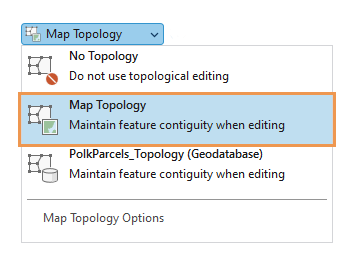Map Topology is a topological editing mode that creates a temporary set of topological relationships for maintaining topological contiguity among coincident and overlapping features as you edit them. It is turned on and off on the ribbon Edit tab in the Manage Edits group.
Additionally, you can isolate topological editing to layers participating in a geodatabase topology rule in the active map. To do this, choose the Geodatabase Topology rule  that appears in the Map Topology drop-down list.
that appears in the Map Topology drop-down list.
Only visible and editable feature layers participate in a map topology. Features that are not visible because of a definition query or an extent that is outside a specified scale range do not update.

The topology graph
The topology graph is a graphic representation of the edges and nodes that define the active topology. It displays over the associated features in the current map extents when topological editing is turned on and a topological editing tool is active.
Topological edits are made by interacting with the edges and nodes using specific editing tools. As you modify them, the relationships for coincident and intersecting geometry are maintained. When you finish an edit, the associated features update.
Line and polygon features:
- An edge with a node at each end represents a contiguous linear boundary. Edges can represent simple two-point line geometry or complex linear shapes that connect to other edges.
- A vertex on an edge defined by two nodes corresponds to the feature vertex on the associated feature that defines its shape.
- A node can also define the intersection of two or more edges.
Point features:
- A node represents a point feature.
- Point feature nodes that are coincident with other nodes are constrained to remain topologically connected.
Tools that edit map topology
When Map Topology is turned on, editing tools that edit topology are listed in the following table:
| Tool | Description |
|---|---|
Align Edge | Reshape a topology edge to match and be coincident with another edge that shares two common topology nodes. For steps to use this tool, see Align topological edges. |
Edit Vertices | Move, delete, or add topology vertices and preserve contiguity between the shared edges. For steps to use this tool, see Edit topological vertices. |
Move | Move topology edges or features and stretch connected edges. For steps to use this tool, see Move topological edges or features |
Reshape | Reshape shared topology edges with a single operation. For steps to use this tool, see Reshape topological edges |
Generalize | Reduce the complexity of a line or a polygon feature, retain its basic shape, and preserve contiguity between shared edges. For steps to use this tool, see Generalize a feature. |




